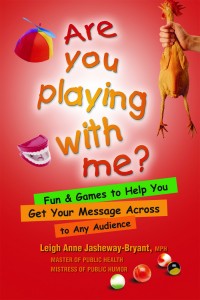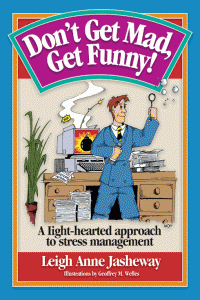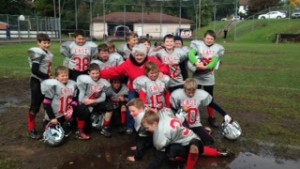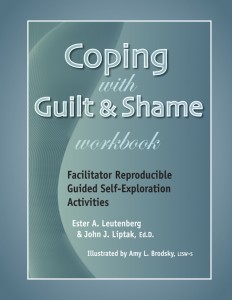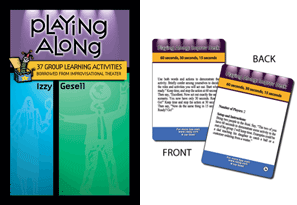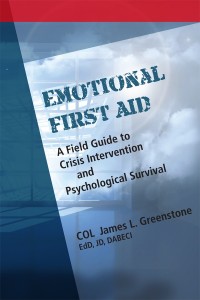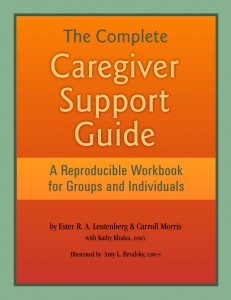What is PTSD and how does it affect our Veterans?
The National Institute of Mental Health defines PTSD this way:
When in danger, it’s natural to feel afraid. This fear triggers many split-second changes in the body to prepare to defend against the danger or to avoid it. This “fight-or-flight” response is a healthy reaction meant to protect a person from harm. But in post-traumatic stress disorder (PTSD), this reaction is changed or damaged. People who have PTSD may feel stressed or frightened even when they’re no longer in danger.
PTSD develops after a terrifying ordeal that involved physical harm or the threat of physical harm. The person who develops PTSD may have been the one who was harmed, the harm may have happened to a loved one, or the person may have witnessed a harmful event that happened to loved ones or strangers.
http://www.nimh.nih.gov/health/topics/post-traumatic-stress-disorder-ptsd/index.shtml Retrieved 11/3/15. (Cut and paste url to view original.)
They go on to say that PTSD was first brought to public attention in relation to war Veterans.
According to the U.S. Department of Veterans Affairs, this continues to be a recurring problem for our returning Veterans. According to their statistics, the number of Veterans with PTSD varies by service era:
Operations Iraqi Freedom (OIF) and Enduring Freedom (OEF): About 11-20 out of every 100 Veterans (or between 11-20%) who served in OIF or OEF have PTSD in a given year.
Gulf War (Desert Storm): About 12 out of every 100 Gulf War Veterans (or 12%) have PTSD in a given year.
Vietnam War: About 15 out of every 100 Vietnam Veterans (or 15%) were currently diagnosed with PTSD at the time of the most recent study in the late 1980s, the National Vietnam Veterans Readjustment Study (NVVRS). It is estimated that about 30 out of every 100 (or 30%) of Vietnam Veterans have had PTSD in their lifetime.http://www.ptsd.va.gov/public/PTSD-overview/basics/how-common-is-ptsd.asp retrieved 11/3/15.
John Sippola, Chaplain, LTC, ret., MDiv, expresses the issue well in his forward to Veterans: Surviving and Thriving After Trauma, by Ester Leutenberg and Carol Butler.
War casts a long shadow. For far too many service members and their families, the initial expressions of welcome, joy and relief are soon overshadowed by hidden wounds to mind, body and spirit. Too many Veterans find they are engaged in yet another desperate battle. And, in this hidden war after the war they discover enemies they feel ill-equipped to fight. Aftershocks of war-related trauma and dangerous undertows of depression sabotage their mission for a more satisfying life in community: Moral injury drowns the quest for inner peace, and substance abuse undermines hard-won gains.
How can we help our Veterans with PTSD? How do we return them to their families and communities healed so they can begin to carve out their “new normal?” How can we make sure that soldiers leaving young families like the one pictured below will return to that family having dealt with the scars of war?
This is, of course, a huge question…far greater than can be answered here.The follow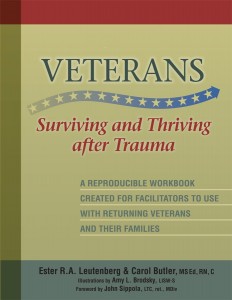 ing is information from Veterans: Surviving an Thriving after Trauma by Ester Leutenberg and Carol Butler. As you will see, it addresses Veterans in language they will easily understand.
ing is information from Veterans: Surviving an Thriving after Trauma by Ester Leutenberg and Carol Butler. As you will see, it addresses Veterans in language they will easily understand.
Education and Assessment
Deceptions and Distortions
This information and exercise below are aimed at the Veteran and ask questions from his/her viewpoint.
DECEPTION in military terms means a strategy that seeks to deceive, trick or fool the enemy and create a false perception in a way that can be leveraged for a military advantage.
DISTORTED THOUGHTS deceive us and make us miserable. Cognitive therapy asserts that thoughts affect feelings which affect actions.
Example: A service person thinks I should have died when my buddy died; I’ll never enjoy life again.
- The service person feels depressed, guilty , hopeless and worthless.
- The service person acts in detrimental ways such as drinking or drugging to escape, driving recklessly, possibly attempting suicide, all because of thinking I don’ t deserve to live.
Example: A partner thinks the changes are very drastic: I don’t even know the person I married.
- The partner feels overwhelmed, unable to understand, scared.
- The partner acts standoffish, fearful, irritated.
Distorted thoughts are your current enemy. They have been camouflaged but now you will recognize them.
Place a check or highlight the distortions that describe ways you usually think.
| DISTORTION |
EXAMPLE |
| All or nothing
Or Black or white |
You see absolutes: right or wrong, good or bad, no middle ground, no gray areas. |
| Overgeneralization |
You see a past failure or trauma as a never ending pattern of defeat or destruction. |
| Mental Filter |
You dwell on negatives Ex: looking at coffee grounds and ignoring the coffee. |
| Discounting the Positives |
You downplay accomplishments; you ignore productive possibilities of trauma. |
| Jumping to Conclusions or Fortune Telling |
You are sure things are bad or will get worse, even though you have no proof. |
| Mind Reading |
You are sure people are against you and thinking the worst about you. |
| Magnification |
You blow things out of proportion, usually negative things. |
| Minimization |
You blow off or ignore positive things, or hard issues you need to face. |
| Emotional Reasoning |
You feel demolished and devastated now, so you decide you are ruined for life. |
| Shoulda, Coulda, Woulda |
You criticize, and regret what should, could, would have been done or not done. |
| Labeling |
You call yourself names or stereotype people who remind you of the enemy. |
| Blame |
You blame yourself for events for which you were not entirely responsible, or you blame others when you have contributed to a situation. |
| Catastrophizing |
You treat challenges as major disasters and expect the worst outcome. |
| Excessive Self-Criticism |
You put yourself down: you are harder on yourself than you are on others. |
| Making Demands |
You expect people to follow your orders – just as when you were in the military. |
| Self-Fulfilling Prophecy |
You expect the worst from yourself and others, and usually get it. |
| Personalization |
You think negative events are your fault or that things happen because of or in response to you, or to a situation you created. |
Insight and Empowerment
Deceptions and Distortions
- Counterforce, a strategy used in nuclear warfare, targets military infrastructure.
- You can counter your cognitive distortions with positive but realistic thoughts.
- You are not expected to minimize the atrocities of war or the severity of your trauma.
- No magic cure exists to undo damage done to you and others.
- Different ways of thinking help you recover.
- Just as there are military police, you can be your own thought police.
- Prior examples show how your thoughts adversely affect your feelings and actions.
- The next examples and exercises show you how changing your thoughts will favorably affect your feelings and actions.
Read the negative example below; note the distortions, resultant feelings and actions.
- Thought: I was traumatized in combat and will never get over it.
- Distortions: Over-generalization, jumping to conclusions, fortune telling.
- Feelings: Discouragement and despair; no hope for recovery.
- Actions: Give up on yourself; refuse help or do not seek help.
Read the positive but realistic replacement thought below; note improved feelings and actions.
- Thought: I was exposed to trauma, but I can get therapy and learn ways to help myself.
- Feelings: Awareness, acceptance, empowerment, hope.
- Actions: Ask for treatment; join support groups; learn techniques for self-help.
Troublesome Thoughts
Describe your most troublesome thoughts below; identify the distortions, resultant feelings and actions. Then replace each thought, noting the improvement in feelings and actions:
- Negative Thought:
________________________________________________________________________________
Distortions:
________________________________________________________________________________
Feelings:
________________________________________________________________________________
Actions:
________________________________________________________________________________
Replacement Thought:
________________________________________________________________________________
Feelings:
________________________________________________________________________________
Actions:
________________________________________________________________________________
- Negative Thought:
________________________________________________________________________________
Distortions:
________________________________________________________________________________
Feelings:
________________________________________________________________________________
Actions:
________________________________________________________________________________
Replacement Thought:
________________________________________________________________________________
Feelings:
________________________________________________________________________________
Actions:
________________________________________________________________________________
- Negative Thought:
________________________________________________________________________________
Distortions:
________________________________________________________________________________
Feelings:
________________________________________________________________________________
Actions:
________________________________________________________________________________
Replacement Thought:
________________________________________________________________________________
Feelings:
________________________________________________________________________________
Actions:
________________________________________________________________________________
- Negative Thought:
________________________________________________________________________________
Distortions:
________________________________________________________________________________
Feelings:
________________________________________________________________________________
Actions:
________________________________________________________________________________
Replacement Thought:
________________________________________________________________________________
Feelings:
________________________________________________________________________________
Actions:
________________________________________________________________________________
5. Decisive Point in military strategy is a geographic place, specific key event, critical system, or function that allows commanders to gain a marked advantage over an enemy and greatly influence the outcome of an attack.
- Your decisive point is now.
- What are the advantages of cognitive counterforce as illustrated by your replacement thoughts in numbers 1-4?
________________________________________________________________________________
________________________________________________________________________________
________________________________________________________________________________
________________________________________________________________________________
6. Consider the following quotations.
Explain why you agree or disagree with each one, and apply each one to your life:
The basis of optimism is sheer terror. ~ Oscar Wilde
________________________________________________________________________________
________________________________________________________________________________
________________________________________________________________________________
________________________________________________________________________________
Oh my friend, it’s not what they take away from you that counts. It’s what you do with what you have left. ~ Hubert Humphrey
________________________________________________________________________________
________________________________________________________________________________
________________________________________________________________________________
________________________________________________________________________________
Life is a shipwreck but we must not forget to sing in the lifeboats. ~ Voltaire
________________________________________________________________________________
________________________________________________________________________________
________________________________________________________________________________
________________________________________________________________________________
There is nothing either good or bad, but thinking makes it so. ~ William Shakespeare
________________________________________________________________________________
________________________________________________________________________________
________________________________________________________________________________
________________________________________________________________________________
Click here to download a printable version of the Veterans exercise above.
- Thank the Veterans you know for their service, no matter when it was.
- Ask what you can do to help if you see a Veteran struggling.
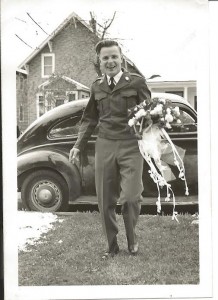
A happy WWII Veteran, Alex Lutkevich, returning home to his bride.
- Talk to your pastor, priest, rabbi or other religious leader about starting an organization for returning Veterans in your church. (An excellent resource: Welcome Them Home, Help Them Heal. Written to equip the growing number of pastors, parish nurses, counselors, and caregivers in churches across the country to support and advocate for Veterans and their loved ones. It expands the reader’s knowledge of how to provide physical, mental, and spiritual care for Veterans and sparks a spirit of willingness and hope.)
- Rejoice that so many willing young people serve our country and support them in any way you can!
Like this:
Like Loading...


